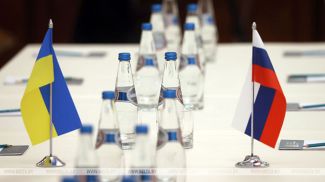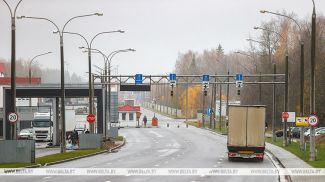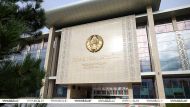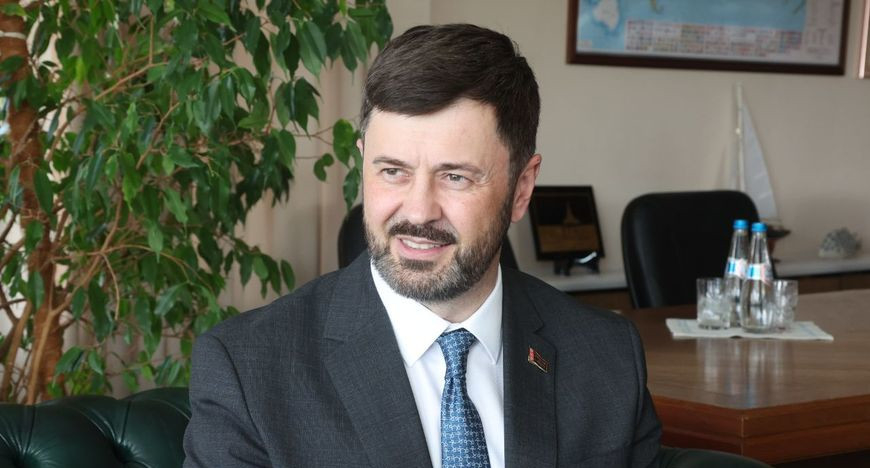
The upcoming Shanghai Cooperation Organization summit in China will serve as a unique platform for frank dialogue, alignment of positions, and the development of collective decisions in today's highly turbulent international environment, Belarusian First Deputy Minister of Foreign Affairs Sergei Lukashevich said in an interview with BelTA in the run-up to the SCO summit in Tianjin on 31 August - 1 September. Belarusian President Aleksandr Lukashenko will attend the event at the invitation of President of the People’s Republic of China Xi Jinping. The deputy minister spoke about Belarus’ cooperation within the SCO, comprehensive cooperation with China, which is mutually beneficial and has been growing.
Mr Lukashevich, the summit is the top priority of China's SCO presidency. It is expected to bring together leaders of over 20 countries and heads of nearly a dozen international organizations. The upcoming Shanghai Cooperation Organisation (SCO) summit in Tianjin will see the adoption of the Tianjin Declaration and the SCO Development Strategy for the next decade. Why is Belarus' participation in this large-scale high-level meeting important?
I will begin by noting that Belarus' work within the Shanghai Cooperation Organization has a historic character. Nearly everything we do within its framework we do for the first time in our history.
In this regard, I would like to quote Minister of Foreign Affairs Maksim Ryzhenkov. While representing Belarus as a full-fledged member state in Tianjin in July 2025 for the first time as, he stated that the first year of Belarus’ membership in the SCO confirmed the correctness of the country’s strategic course to join the organization.
Indeed, Shanghai Cooperation Organization summits are not merely formal meetings. They serve as a unique platform for frank dialogue, alignment of positions, and the development of collective decisions in an atmosphere of mutual respect and equality. For Belarus, participation in this format is an opportunity to engage with world leaders within a friendly circle where trust and partnership are genuinely valued. Such negotiations create conditions for more coordinated interaction within the SCO’s multilateral frameworks.
A vivid example of successful cooperation between our countries will be the Pujiang Innovation Forum that will be running in Shanghai from 20 to 22 September 2025 and that Belarus will attend in the capacity of the guest of honor. The forum will summarize the results of the Years of Cooperation between Belarus and China in Science, Technology, and Innovation (2024-2025) and identify promising and mutually beneficial areas for future joint collaboration.
Overall, more than 50 events in the field of scientific and technological exchanges have been conducted over the two years. Over 30 joint platforms for cooperation development have been established. Sixty-five research projects are in progress. More than 50 Chinese scientific delegations from various regions have visited Belarus with the aim of establishing partnership relations.
Will you name the most significant completed and ongoing Belarusian-Chinese projects?
The implementation of joint projects contributes to the economic development of Belarus, attracts investment and technology, and strengthens the country's position on the international stage.
The largest and most significant project of bilateral cooperation and the global Belt and Road Initiative is the Great Stone Industrial Park. It is developing under the patronage of the leaders of both countries and is China's largest overseas industrial park.
To date, the park has 154 registered residents from 15 countries, with a total declared investment volume of approximately $1.6 billion and plans to create over 16,000 jobs. More than 70% of the projects being implemented belong to the 5th and 6th technological paradigms. These are projects in mechanical engineering, electronics, telecommunications, biotechnology, pharmaceuticals, fine chemicals, new materials production, and R&D. Furthermore, 62 park residents were established with Chinese capital participation. The development of high-tech production in the park aligns with China's strategy of promoting innovation and exporting technology. I believe that joint Belarusian-Chinese enterprises will become a driver of development not only for Belarus but also for adjacent regions.
Within the framework of Belarus-China industrial and technological cooperation, I would highlight the well-known project with the Geely Corporation – increasing the production of vehicles at the BelGee car making factory to 120,000 units per year (production modernization is underway, with localization efforts in full swing, including the construction of a stamping production facility).
In the field of agriculture, I can mention the project to establish a joint venture for dairy production in Changsha, Hunan Province through the cooperation of Babushkina Krynka with a Chinese partner. We also assess positively the project to set up a joint trading enterprise in Dalian, Liaoning Province, within which Savushkin Product established the joint trading enterprise Savushkin (Dalian) Intl Trading Co., Ltd with the goal of exporting a wide range of products manufactured by enterprises in Brest Oblast.
Furthermore, the Belarusian National Biotechnology Corporation has become a strategically important project for Belarus in the development of a modern biotechnology industry. The project is a priority for ensuring the country's food security, creating new jobs, and increasing export potential.
In the healthcare sector, the state enterprise Belpharmprom and its affiliated enterprises are implementing projects with Chinese partners in the production of pharmaceutical substances and traditional Chinese medicine. The possibility of organizing the production of traditional Chinese medicine drugs in Belarus is being explored.
Separately, I would like to mention the construction of social infrastructure facilities. China's participation in such projects not only contributes to the economic and social development of Belarusian society but also strengthens the friendship between our peoples. Examples of such projects include the National Football Stadium and the International Standard Swimming Pool built in Minsk through funds from Chinese technical and economic assistance. Even the challenging period of the pandemic did not prevent our countries from completing their construction on schedule. These modern sports facilities not only enable us to host international-level competitions but also inspire young people to engage in sports and lead a healthy lifestyle.
As you can see, much has already been accomplished or is in the process of implementation. This result has been made possible in part due to the engagement, initiative, and energetic work of the official assigned to China – Belarusian First Deputy Prime Minister Nikolai Snopkov - both in terms of coordinating new large-scale projects and in ensuring the daily coordinated work of all Belarusian government bodies in addressing the tasks facing Belarus.
What new projects are planned for bilateral cooperation?
China views Belarus as a key partner within the massive Belt and Road Initiative, which entails long-term investments and the implementation of joint projects aimed at developing industry, trade, and transport infrastructure. This partnership plays a vital role in strengthening Belarus' economic sovereignty.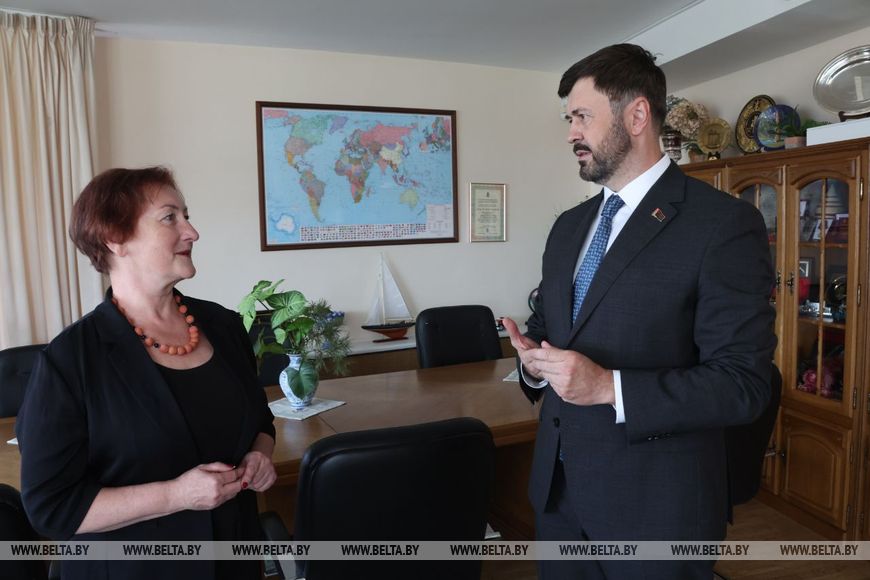
Following the visit of Premier of the State Council of the People's Republic of China Li Qiang to Belarus in August 2024, the governments of our countries have been tasked with studying and ensuring the implementation of China's modernization experience, developing new quality productive forces through joint projects, and introducing Chinese technologies in Belarus.
Significant work is conducted in this area. The active portfolio of investment projects for which Chinese partners are being sought includes ventures in wood processing, petrochemicals, construction materials production, light industry, and agriculture.
In industrial cooperation, work in automotive manufacturing will continue. Furthermore, new projects for the production of engines, hydraulic systems, cabs, and axles will be implemented.
Under the line of technical and economic assistance, there are plans to execute a project for the construction of the Belarusian National Museum. The idea of creating the complex with China's participation is a personal initiative of Belarusian President Aleksandr Lukashenko.
Moreover, an important direction in bilateral relations is the development of transport corridors and logistics. Belarus counts on strengthening its role as a key transit hub within the framework of the SCO Agreement on International Road Transportation Facilitation. Belarus' transport complex possesses all the necessary potential to handle the transportation of the growing volume of trade with the People's Republic of China.
I would like to draw attention to another promising area for developing cooperation with Chinese partners - the digital economy and information and communication technologies (ICT). Belarus and China will develop cooperation on the implementation of joint projects in digital transformation, cloud technologies, artificial intelligence, digital medicine, and ICT personnel training. Interaction is planned for the development of smart cities, the creation of joint high-tech product manufacturing, and a Chinese-Belarusian platform for cooperation in ICT.
Are there any areas not yet involved in Belarus-China cooperation?
Today, Belarusian-Chinese cooperation encompasses virtually all key areas, ranging from political interaction and joint economic projects to scientific-technological exchanges, educational programs, cultural initiatives, and coordination on matters of preserving historical memory.
The partnership is strategic in nature and is built on the principle of ‘comprehensive cooperation without off-limits topics’, which allows for the rapid launch of new projects whenever interest or need arises.
Minsk and Beijing openly declare their readiness to deepen ties across all areas, from high technology and logistics to humanitarian contacts and joint work on international platforms.
Mr Lukashevich, how do you see the prospects for partnership between our countries in the next five years?
Before discussing the prospects for our countries' partnership in the next five-year period, I would like to outline the context of the main trends in our cooperation in recent years. I would like to note that the last two years have been challenging, yet active and productive. This is evidenced by the substantive depth of practically all visits that occurred during this period at the highest and high levels. A significant number of bilateral documents have been signed, demonstrating both countries' commitment to openness and to increasing and deepening interaction across various fields.
In foreign trade, constant work is conducted to increase and diversify exports, adapt goods to the Chinese market, and raise the number of Belarusian enterprises accredited for supplies to China. Interaction with Chinese industry-specific government bodies, chambers of commerce, and trade associations is being strengthened. E-commerce mechanisms are being actively introduced into bilateral trade. Work is also underway to develop and establish efficient transport corridors.
Furthermore, significant attention is paid to enhancing interregional cooperation and transitioning towards a more applied nature of collaboration, specifically, the implementation of concrete investment projects and trade initiatives by regional enterprises from both countries.
During the official visit of Belarusian President Aleksandr Lukashenko to China in March 2023, the Belarusian Industry Ministry and the Ministry of Industry and Information Technology of China signed a comprehensive strategy for joint industrial development. This strategy defined the priorities for the further development of Belarusian-Chinese industrial cooperation and the main mechanisms for interaction. In November 2023, a series of documents on aligning the industrial policies of the two countries were signed, which identified specific projects and directions for cooperation in mechanical engineering, automotive manufacturing, wood processing, chemical industry, and other sectors.
New strategic areas for industrial cooperation are being actively developed with Chinese partners, including in the production of automotive components, machine tool building, deep wood processing, and the production of agricultural products.
The launch of the Belarus-China Years of Cooperation in Science, Technology, and Innovation was announced during the visit of the premier of the State Council of the People's Republic of China to Belarus in August 2024. The Belarusian head of state then proposed to the Chinese side that the core task for the governments of the two countries should be the realization of a large-scale influx of Chinese technologies into Belarus. The reason is obvious. Today, China is a recognized leader in the field of innovation. It is in China that technological megaprojects are being implemented. Belarus has retained, since Soviet times, the highest competencies in microelectronics, mechanical engineering, and the space industry. Our country possesses enormous scientific and technical potential, including in the IT sector. It is entirely evident that combining our competencies with China's technological potential will facilitate an intensive transition to a higher technological level of industrial development.
In the area of scientific and technological interaction, dozens of events have been implemented in 2024-2025, providing for the development of Belarusian-Chinese cooperation platforms and the execution of joint scientific and sci-tech projects.
To advance the technological direction, a bilateral commission on industrial cooperation was established within the framework of the Intergovernmental Committee in May 2025. During Aleksandr Lukashenko's visit to China in June 2025, one of the key tasks for our countries' cooperation was identified as focusing joint efforts on deepening industrial cooperation for at least the next two years.
I am confident that industrial cooperation, technological partnership, the introduction of modern technologies, and the creation of joint high-tech enterprises will become the main trends in our states' cooperation in the near future.
Belarus views the prospects of its all-weather comprehensive strategic partnership with China positively and with confidence.
Alina GRISHKEVICH BelTA
Mr Lukashevich, the summit is the top priority of China's SCO presidency. It is expected to bring together leaders of over 20 countries and heads of nearly a dozen international organizations. The upcoming Shanghai Cooperation Organisation (SCO) summit in Tianjin will see the adoption of the Tianjin Declaration and the SCO Development Strategy for the next decade. Why is Belarus' participation in this large-scale high-level meeting important?
I will begin by noting that Belarus' work within the Shanghai Cooperation Organization has a historic character. Nearly everything we do within its framework we do for the first time in our history.
In this regard, I would like to quote Minister of Foreign Affairs Maksim Ryzhenkov. While representing Belarus as a full-fledged member state in Tianjin in July 2025 for the first time as, he stated that the first year of Belarus’ membership in the SCO confirmed the correctness of the country’s strategic course to join the organization.
Indeed, Shanghai Cooperation Organization summits are not merely formal meetings. They serve as a unique platform for frank dialogue, alignment of positions, and the development of collective decisions in an atmosphere of mutual respect and equality. For Belarus, participation in this format is an opportunity to engage with world leaders within a friendly circle where trust and partnership are genuinely valued. Such negotiations create conditions for more coordinated interaction within the SCO’s multilateral frameworks.
Over the past year, Belarus has managed to maximally increase its presence across all areas of SCO activity and, without delay, actively engage in its work. For instance, Belarus attended 25 meetings of SCO ministerial and agency heads and 26 events at the working group level. Moreover, on 5 June 2025, Belarusbank was admitted to the SCO Interbank Consortium. In May of this year, six Belarusian universities, namely BSU, BNUT, BSUIR, Francysk Skaryna Gomel State University, Pavel Sukhoi Gomel State Technical University, and Masherov Vitebsk State University joined the activities of the SCO University.
We have become convinced that within the SCO framework, Belarus can pursue its strategic priorities, promote multifaceted cooperation, and contribute to joint projects.
The Belarusian side is confident that the summit will result in decisions that strengthen the SCO's institutional potential, primarily in part of joint efforts to combat transnational challenges: terrorism, cyber threats, and drug trafficking. On the economic front, we anticipate initiatives to simplify customs procedures, stimulate mutual investments, develop the digital economy and transport interconnectivity, and support green energy. We are also prepared to work on expanding humanitarian exchanges.
All these areas are extremely important for the Republic of Belarus.
Moreover, the SCO summit serves as a venue for communication among the highest political leadership of member states, which opens broad opportunities for personal dialogue and direct interaction between the heads of state.
The Belarusian head of state was also invited to events in Beijing to celebrate the 80th anniversary of Victory in World War II. How close are the positions of Belarus and China in preserving historical memory?
Both countries view the events of World War II not merely as a significant historical chapter, but as a fundamental element of national identity and state narrative. For us, the period of the Great Patriotic War holds particular importance. It is widely known that our republic was among the most severely affected territories of the Soviet Union. Themes of heroism, national unity, and resistance against Nazi occupation hold a special place in our collective memory. 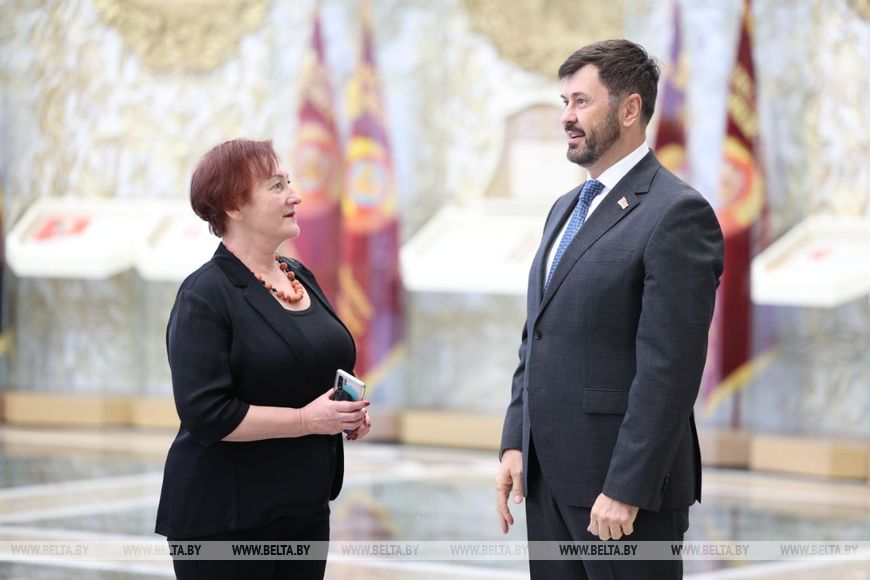

The Constitution of the Republic of Belarus enshrines that the state ensures the preservation of historical truth and the memory of the heroic feat of the Belarusian people during the Great Patriotic War. Belarusian President Aleksandr Lukashenko emphasized: "There is no nobler mission than preserving historical memory for the sake of a bright future.”
For China, the central episode remains the War of Resistance Against Japanese Aggression, which was marked by millions of casualties and immense devastation. In its historical memory, great importance is placed on the resilience of the people, the sacrifices made for the sake of victory, and China’s role as a crucial front in the global struggle against fascism and militarism. Here, as in Belarus, the state actively shapes and upholds this historical narrative to pass it on to future generations, strengthen patriotism, and emphasize the continuity of its historical mission.
Our leaders hold common approaches to this issue. The similarity in approaches is also reflected in the fact that both countries categorically reject any attempts to revise the outcomes of World War II or diminish the role of our peoples in defeating the aggressors.
It is also important that we did not merely fight our respective enemies on different fronts but also supported each other. We remember the names of Chinese soldiers who fought in the ranks of the Red Army and partisan units, the underground resistance in the city of Vitebsk. We honor the Belarusian heroes who gave their lives combating Japanese aggressors in the skies and on the land of China.
Therefore, the Belarusian president has been invited by the leader of the People's Republic of China to attend the commemorative events, one of which is the parade in Beijing marking the 80th anniversary of Victory.
Belarus and China are united in their commitment to carefully preserve and protect the memory of the war, viewing it as part of a shared heritage that must not be allowed to be distorted or forgotten.
Mr Lukashevich, the level of Belarusian-Chinese interaction is exceptionally high: all-weather and comprehensive strategic partnership. Will you tell us more about it and whether we have made more progress recently?
Belarusian-Chinese cooperation has evolved from isolated contacts to an all-weather comprehensive strategic partnership since the establishment of diplomatic relations. Over the years, a solid political foundation has been built, significantly strengthened by the friendship between the leaders of the two countries. Mutual visits and meetings at the highest and high levels have become regular, and interagency and interregional contacts are actively developing.
Today, China is our second-largest trading partner and one of the leading sources of foreign direct investment. Over the past 10 years, bilateral trade has increased more than 4.5-fold. Belarus’ major exports to China include a diverse range of goods, including potash fertilizers, rapeseed oil, poultry products, timber, beef, cellulose, and an increasingly wide array of new products: from processed meat items, casein, soybean oil, and fresh beef to starch, spirits, and mineral water.
Key flagship examples of bilateral cooperation include: the Great Stone Industrial Park (the largest and most successful facility of its kind in the post-Soviet space); the Belarusian-Chinese joint venture BelGee, which produces modern automobiles demanded both domestically and internationally; and the Belarusian National Biotechnology Corporation, a critical element for food security and technological modernization of the agricultural sector, among others. These projects not only strengthen Belarus's economy but also shape a new vision for Belarusian-Chinese strategic partnership, built on a high level of trust, respect, and mutual benefit.
In August 2024, in Minsk, an agreement was reached between then-Prime Minister Roman Golovchenko and Premier of the State Council of the People's Republic of China Li Qiang to fill bilateral cooperation with new economic content—focusing on joint technological development and the integration of modern Chinese technologies into the Belarusian economy.
I would like to emphasize that these conceptual approaches are enshrined in a joint communiqué and outline the objectives until 2030: studying China’s modernization experience, developing new quality productive forces, and technological retrofitting of Belarusian enterprises. Among the key areas are deepening cooperation within the Belt and Road initiative, strengthening production and supply chains, developing the Great Stone Industrial Park, expanding collaboration in science and technology, establishing joint laboratories, research centers, and high-tech production facilities, and fostering cooperation in artificial intelligence, digital medicine, smart cities, robotics, and other promising fields. All of this represents a substantial foundation for Belarus's sustainable development in the future.
To implement these objectives, 28 documents were signed in 2024, including a plan for aligning the Belt and Road initiative with Belarus’s National Strategy for Sustainable Development, an agreement on trade in services and investments, and a memorandum on strategic cooperation in the ICT sector. At the same time, particular attention is being paid to the green economy, low-carbon technologies, and the development of transport interconnectivity. Notably, in addition to the Minsk-Beijing-Minsk flight, new air routes were opened in 2024: Minsk- Ürümqi -Minsk and Beijing-Xi'an-Minsk. These routes not only strengthen cultural and business ties but also create new economic opportunities.
It is fitting to quote the Belarusian head of state: "Belarus is a reliable friend of the Chinese people. This will always be the case." Over three decades, Belarus and China have evolved from simple trade to a comprehensive, mutually beneficial strategic partnership encompassing politics and economics, science and technology, transportation, education, culture, and many other avenues.
What topics and issues are currently the most relevant for Belarus-China interaction?
Today, our joint agenda is spearheaded by scientific-technological cooperation and the technological modernization of industry. This priority was formulated by the leaders of China and Belarus following a trust-based, friendly dialogue.
I would like to emphasize that, building on the comprehensive strategic partnership between Belarus and China and the solid foundation of the Belt and Road Initiative, scientific and technological contacts between the two countries are reaching a qualitatively new, strategic, and innovative level. Looking ahead, Belarus and China intend to fully leverage their complementary advantages in science and technology, consistently implement a strategy for joint breakthroughs in advanced fields, continue efforts to establish collaborative platforms, and carry out a long-term program for training scientific and technical personnel.
Based on strategic trust, our countries are not only generating powerful momentum for modernizing national industries but are also becoming a key hub for scientific and technological cooperation across the Eurasian space. This collaboration makes a substantial contribution to shaping an open and inclusive system for the global governance of scientific and technological development.
Overall, more than 50 events in the field of scientific and technological exchanges have been conducted over the two years. Over 30 joint platforms for cooperation development have been established. Sixty-five research projects are in progress. More than 50 Chinese scientific delegations from various regions have visited Belarus with the aim of establishing partnership relations.
Will you name the most significant completed and ongoing Belarusian-Chinese projects?
The implementation of joint projects contributes to the economic development of Belarus, attracts investment and technology, and strengthens the country's position on the international stage.
The largest and most significant project of bilateral cooperation and the global Belt and Road Initiative is the Great Stone Industrial Park. It is developing under the patronage of the leaders of both countries and is China's largest overseas industrial park.
To date, the park has 154 registered residents from 15 countries, with a total declared investment volume of approximately $1.6 billion and plans to create over 16,000 jobs. More than 70% of the projects being implemented belong to the 5th and 6th technological paradigms. These are projects in mechanical engineering, electronics, telecommunications, biotechnology, pharmaceuticals, fine chemicals, new materials production, and R&D. Furthermore, 62 park residents were established with Chinese capital participation. The development of high-tech production in the park aligns with China's strategy of promoting innovation and exporting technology. I believe that joint Belarusian-Chinese enterprises will become a driver of development not only for Belarus but also for adjacent regions.
Within the framework of Belarus-China industrial and technological cooperation, I would highlight the well-known project with the Geely Corporation – increasing the production of vehicles at the BelGee car making factory to 120,000 units per year (production modernization is underway, with localization efforts in full swing, including the construction of a stamping production facility).
In the field of agriculture, I can mention the project to establish a joint venture for dairy production in Changsha, Hunan Province through the cooperation of Babushkina Krynka with a Chinese partner. We also assess positively the project to set up a joint trading enterprise in Dalian, Liaoning Province, within which Savushkin Product established the joint trading enterprise Savushkin (Dalian) Intl Trading Co., Ltd with the goal of exporting a wide range of products manufactured by enterprises in Brest Oblast.
Furthermore, the Belarusian National Biotechnology Corporation has become a strategically important project for Belarus in the development of a modern biotechnology industry. The project is a priority for ensuring the country's food security, creating new jobs, and increasing export potential.
In the healthcare sector, the state enterprise Belpharmprom and its affiliated enterprises are implementing projects with Chinese partners in the production of pharmaceutical substances and traditional Chinese medicine. The possibility of organizing the production of traditional Chinese medicine drugs in Belarus is being explored.
Separately, I would like to mention the construction of social infrastructure facilities. China's participation in such projects not only contributes to the economic and social development of Belarusian society but also strengthens the friendship between our peoples. Examples of such projects include the National Football Stadium and the International Standard Swimming Pool built in Minsk through funds from Chinese technical and economic assistance. Even the challenging period of the pandemic did not prevent our countries from completing their construction on schedule. These modern sports facilities not only enable us to host international-level competitions but also inspire young people to engage in sports and lead a healthy lifestyle.
As you can see, much has already been accomplished or is in the process of implementation. This result has been made possible in part due to the engagement, initiative, and energetic work of the official assigned to China – Belarusian First Deputy Prime Minister Nikolai Snopkov - both in terms of coordinating new large-scale projects and in ensuring the daily coordinated work of all Belarusian government bodies in addressing the tasks facing Belarus.
What new projects are planned for bilateral cooperation?
China views Belarus as a key partner within the massive Belt and Road Initiative, which entails long-term investments and the implementation of joint projects aimed at developing industry, trade, and transport infrastructure. This partnership plays a vital role in strengthening Belarus' economic sovereignty.

Following the visit of Premier of the State Council of the People's Republic of China Li Qiang to Belarus in August 2024, the governments of our countries have been tasked with studying and ensuring the implementation of China's modernization experience, developing new quality productive forces through joint projects, and introducing Chinese technologies in Belarus.
Significant work is conducted in this area. The active portfolio of investment projects for which Chinese partners are being sought includes ventures in wood processing, petrochemicals, construction materials production, light industry, and agriculture.
In industrial cooperation, work in automotive manufacturing will continue. Furthermore, new projects for the production of engines, hydraulic systems, cabs, and axles will be implemented.
Under the line of technical and economic assistance, there are plans to execute a project for the construction of the Belarusian National Museum. The idea of creating the complex with China's participation is a personal initiative of Belarusian President Aleksandr Lukashenko.
Moreover, an important direction in bilateral relations is the development of transport corridors and logistics. Belarus counts on strengthening its role as a key transit hub within the framework of the SCO Agreement on International Road Transportation Facilitation. Belarus' transport complex possesses all the necessary potential to handle the transportation of the growing volume of trade with the People's Republic of China.
I would like to draw attention to another promising area for developing cooperation with Chinese partners - the digital economy and information and communication technologies (ICT). Belarus and China will develop cooperation on the implementation of joint projects in digital transformation, cloud technologies, artificial intelligence, digital medicine, and ICT personnel training. Interaction is planned for the development of smart cities, the creation of joint high-tech product manufacturing, and a Chinese-Belarusian platform for cooperation in ICT.
Are there any areas not yet involved in Belarus-China cooperation?
Today, Belarusian-Chinese cooperation encompasses virtually all key areas, ranging from political interaction and joint economic projects to scientific-technological exchanges, educational programs, cultural initiatives, and coordination on matters of preserving historical memory.
The partnership is strategic in nature and is built on the principle of ‘comprehensive cooperation without off-limits topics’, which allows for the rapid launch of new projects whenever interest or need arises.
Minsk and Beijing openly declare their readiness to deepen ties across all areas, from high technology and logistics to humanitarian contacts and joint work on international platforms.
Mr Lukashevich, how do you see the prospects for partnership between our countries in the next five years?
Before discussing the prospects for our countries' partnership in the next five-year period, I would like to outline the context of the main trends in our cooperation in recent years. I would like to note that the last two years have been challenging, yet active and productive. This is evidenced by the substantive depth of practically all visits that occurred during this period at the highest and high levels. A significant number of bilateral documents have been signed, demonstrating both countries' commitment to openness and to increasing and deepening interaction across various fields.
In foreign trade, constant work is conducted to increase and diversify exports, adapt goods to the Chinese market, and raise the number of Belarusian enterprises accredited for supplies to China. Interaction with Chinese industry-specific government bodies, chambers of commerce, and trade associations is being strengthened. E-commerce mechanisms are being actively introduced into bilateral trade. Work is also underway to develop and establish efficient transport corridors.
Furthermore, significant attention is paid to enhancing interregional cooperation and transitioning towards a more applied nature of collaboration, specifically, the implementation of concrete investment projects and trade initiatives by regional enterprises from both countries.
During the official visit of Belarusian President Aleksandr Lukashenko to China in March 2023, the Belarusian Industry Ministry and the Ministry of Industry and Information Technology of China signed a comprehensive strategy for joint industrial development. This strategy defined the priorities for the further development of Belarusian-Chinese industrial cooperation and the main mechanisms for interaction. In November 2023, a series of documents on aligning the industrial policies of the two countries were signed, which identified specific projects and directions for cooperation in mechanical engineering, automotive manufacturing, wood processing, chemical industry, and other sectors.

New strategic areas for industrial cooperation are being actively developed with Chinese partners, including in the production of automotive components, machine tool building, deep wood processing, and the production of agricultural products.
The launch of the Belarus-China Years of Cooperation in Science, Technology, and Innovation was announced during the visit of the premier of the State Council of the People's Republic of China to Belarus in August 2024. The Belarusian head of state then proposed to the Chinese side that the core task for the governments of the two countries should be the realization of a large-scale influx of Chinese technologies into Belarus. The reason is obvious. Today, China is a recognized leader in the field of innovation. It is in China that technological megaprojects are being implemented. Belarus has retained, since Soviet times, the highest competencies in microelectronics, mechanical engineering, and the space industry. Our country possesses enormous scientific and technical potential, including in the IT sector. It is entirely evident that combining our competencies with China's technological potential will facilitate an intensive transition to a higher technological level of industrial development.
In the area of scientific and technological interaction, dozens of events have been implemented in 2024-2025, providing for the development of Belarusian-Chinese cooperation platforms and the execution of joint scientific and sci-tech projects.
To advance the technological direction, a bilateral commission on industrial cooperation was established within the framework of the Intergovernmental Committee in May 2025. During Aleksandr Lukashenko's visit to China in June 2025, one of the key tasks for our countries' cooperation was identified as focusing joint efforts on deepening industrial cooperation for at least the next two years.
I am confident that industrial cooperation, technological partnership, the introduction of modern technologies, and the creation of joint high-tech enterprises will become the main trends in our states' cooperation in the near future.
Belarus views the prospects of its all-weather comprehensive strategic partnership with China positively and with confidence.
Alina GRISHKEVICH BelTA







